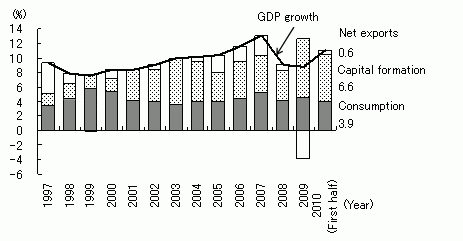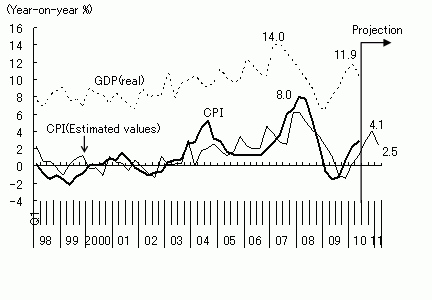The Chinese economy has successfully achieved a V-shaped recovery from the global financial crisis. At the same time, however, inflation has been rising, and the real estate bubble is back. To maintain its impressive growth, China needs to rein in the economic overheating in the short term and improve its economic structure over the long run. Thanks to an appropriate response by the government, real estate prices have already begun falling, and inflation has shown signs of easing. In addition, growth is accelerating in the service industry, inland areas, and rural areas, bringing new vitality to the Chinese economy.
Sense of overheating strengthened by economic recovery
Although the economic recovery was initially driven by domestic demand, such as investment-particularly in infrastructure--and private consumption, exports have also been picking up since the beginning of this year. GDP growth in the first half of 2010 was 11.1% (11.9% in the first quarter and 10.3% in the second quarter). By demand component, while the contributions of both capital formation (investment) and consumption declined slightly from last year's high levels, to 6.6% and 3.9%, respectively, that of net exports turned from a substantial negative into a positive 0.6%, pushing up the economic growth rate ( Figure 1 ).

(Note)For 2010, the first half only. Capital formation includes an increase in inventories (inventory invstment).
(Source)Based on the "China Statistical Abstract" 2009, and the press release (on July 15, 2010) of the National Bureau of Statistics of China.
With the economy recovering, inflationary pressure has been rising, and real estate prices have climbed. In the second quarter of 2010, the inflation rate rose to 2.9%, the highest level since the third quarter of 2008. It has been observed that inflation rate moves approximately three quarters behind economic growth in China. Based on this historical pattern, inflation is projected to keep rising until the fourth quarter of 2010, given that economic growth peaked in the first quarter of 2010 ( Figure 2 ). Also, as housing prices in 70 large and medium cities have been increasing at a double-digit clip year-on-year February 2010, the real estate market has been displaying evidence of an asset bubble.

(Note)Estimated values of CPI are based on regression analysis.

Estimation period: The first quarter (Q1) of 1998 to the second quarter (Q2) of 2010
(Source)Based on data of the National Bureau of Statistics of China.
Policy adjustment for stable growth
For stable growth, the Chinese authorities have embarked on credit tightening, action against the real estate bubble, and exchange rate reform.
First, with respect to monetary policy, the quantitative credit control imposed on banks, which had been loosened significantly after the collapse of Lehman Brothers, was tightened once again in the spring of 2009. As a result, growth in bank lending (on a year-on-year basis) has slowed from 34.4% at its peak in June 2009 to only 18.2% in June 2010, partly helped by three hikes totaling 1.5 percentage points in reserve requirements for banks since the beginning of this year. Given the quick response of the monetary authorities, inflation could peak earlier than the above projection based on its relationship with the economic growth rate.
Also, in responding to the real estate bubble, the Chinese authorities placed restrictions on housing loans in mid-April 2010. As a result, the real estate market has entered a stage of correction, with home sales falling sharply and prices beginning to drop.
As for foreign exchange policy, the yuan moved back to the managed floating rate system from the de facto dollar peg system in mid-June for the first time in approximately two years. Since then, the exchange rate of the yuan against the U.S. dollar has been following a moderate upward trend. It is expected that the yuan will be allow to appreciate by 5-6% against the U.S. dollar over the next year. As a result, the trade friction with the United States and the domestic inflationary pressure are likely to be somewhat mitigated.
Three structural changes worth noting
When considering the sustainability of economic growth in China, in addition to developments in macroeconomic policy, the structural changes considered below are noteworthy:
First, the industrial core has been shifting from secondary industry (manufacturing) to tertiary industry (services) in line with the conversion of the growth pattern sought by the government. In the first half of 2010, the tertiary industry's share of GDP rose 1.3 percentage points from its level a year earlier to 42.6%, while that of the secondary industry fell 0.4 percentage points, to 49.7%.
Also, inland areas (composing the western and the central regions) have been growing faster than coastal areas (the eastern region), and as a result, regional disparities have begun to shrink. In the first half of 2010, growth in industrial production (on a value-added basis, covering only enterprises with annual sales over 5 million yuan) reached 20.7% in the central region and 17.6% in the western region, both of which were higher than that in the eastern region (16.7%). Investment in fixed assets also grew faster in the central region (28.0%) and the western region (27.3%) than in the eastern region (22.4%). The phenomenon of "the inland areas growing faster than the coastal areas," which began to emerge in 2007, is expected to continue, reflecting the accelerated relocation of industries from the latter to the former.
In addition, urban and rural differences in income and consumption, which had consistently been widening in the past, have also been halted. Growth in per capita income reached 9.5% for the rural population on a year-on-year basis in the first half of 2010, higher than 7.5% for the urban population. Reflecting this, growth in per capita consumption expenditure (real) is higher for the rural population (8.5%) than it is for the urban population (7.2%).
In China, although development in the service industry, the Inland region, and rural areas has hitherto been lagging in comparison with other industries and regions, they nevertheless have higher growth potential and are expected to become new engines to lead the Chinese economy in the years ahead.


